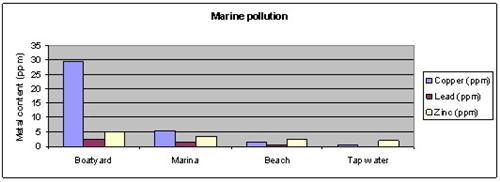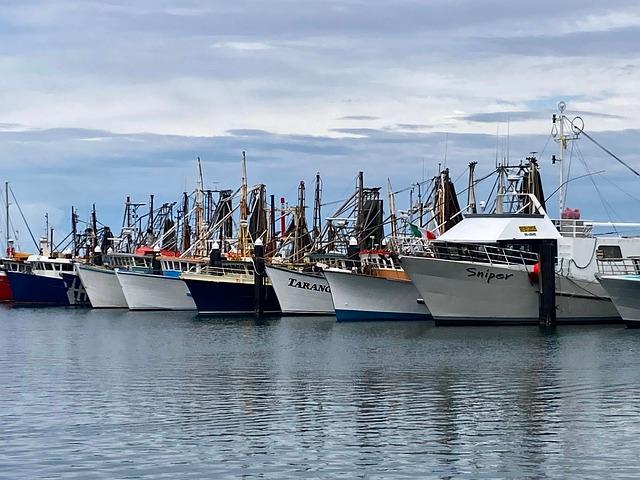| Complexity level: | 5 |
| Project cost ($): | 150 |
| Time required: | 1 hour for preparation, 1 day for experiment |
| Material availability: | Easily found. However, transportation to the various locations, as well as access to a laboratory, is required |
| Safety concerns: | Be careful when gathering water samples at the boatyard. Adult supervision required. |
Hypothesis
The water sample obtained from the boatyard will have the highest level of copper content.
Overview
Boatyard pollution
Most ships and boats will have their bases painted with an antifouling paint. This paint helps to prevent the growth of barnacles and other types of marine organisms on the hull of the boat. The presence of these organisms will reduce the speed of the boat and also affect its fuel efficiency.
The most common active ingredient in antifouling paint is copper. High concentrations of copper can be found in antifouling paint. Even though copper is very effective in deterring the growth of organisms on the base of boats, it is also harmful to marine life.
Despite being coated with antifouling paint, boats still need to be cleaned and existing organisms removed once a year. This is normally done by raising the boat on a ramp and washing the bottom of the boat using a high pressure jet of water, which unfortunately also chips paint off from the surface of the boat. After cleaning, the dirty water needs to be processed and cleaned thoroughly before it can be released back into the environment, to prevent the contamination of seawater and ground water. This contaminated water may even be hazardous to the workers performing the cleaning.
Scientific Terms
Materials
The materials required for this science fair project:
- 40 small glass bottles
- writing materials
Procedure
1. For this science fair project, the independent variable is the location where the water samples are obtained– a boatyard, a boat marina, a beach and tap water. The dependent variable is the amount of copper, lead and zinc found in the water samples. This is determined by sending the water samples to an independent laboratory for testing. The constants (control variables) are the amount of water samples collected and the distance of the location from the boatyard where water samples are collected from.
2. With the black marker, label the glass bottles ‘boatyard’, ‘marina’, ‘beach’ and ‘tap water’.
3. Fill each bottle with water from the appropriate location. 10 samples should be taken from each of the locations.
4. Send the 40 bottles to a laboratory equipped to test for heavy metals to determine the levels of copper, lead and zinc in each water sample.

Results
The results show that the water sample obtained near the boatyard contained the highest amount of copper, lead and zinc, followed by the water sample from the marina area.
| Heavy metal in water | Metal content in water samples (ppm) | |||
| Boatyard | Marina | Beach | Tap water | |
| Copper (ppm) | 39.5 | 5.5 | 1.5 | 0.5 |
| Lead (ppm) | 2.5 | 1.5 | 0.5 | 0.01 |
| Zinc (ppm) | 5 | 3.5 | 2.5 | 2 |
The above results were then plotted onto a graph, as shown below.

Conclusion
The hypothesis that the water samples obtained from the boatyard will have the highest level of copper content has been proven to be true.
One of the sources of marine pollution in our oceans is the shipbuilding and repair industry. Although the industry helps support the local economy and provides jobs for people who live nearby, it poses a lot of environmental problems due to the discharge of antifouling paint and other chemicals pollutants. Discharge of heavy metal wastes into the sea will eventually end up in our food chain as copper is known to harm marine life, and may lead to poisoning of our seafood suppliesn.
Also consider
The science fair project may be repeated by collecting water samples from other locations, such as ship ports or beaches along busy shipping routes.
The experiment may also be modified to test for other pollutants such as oil or organic chemicals.
References
Pressure washing overview - http://www.mass.gov/czm/marinas/pressurewashing/pw_info.htm
Marine pollution - http://courses.ma.org/classes/oceanography/swong/home.html
Small shipyards and boatyards in Oregon - http://www.pprc.org/pubs/shipyard/oregon/rt_rept.html

